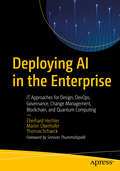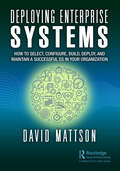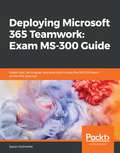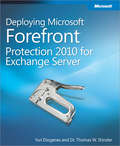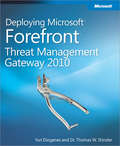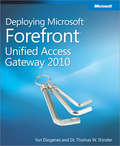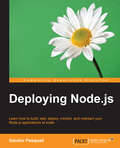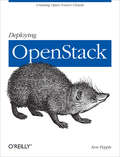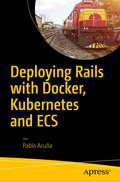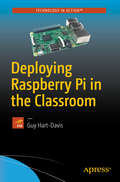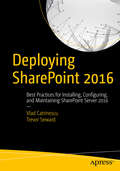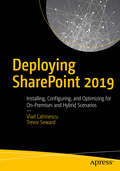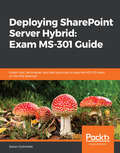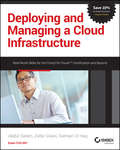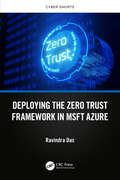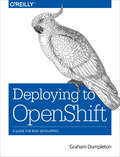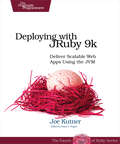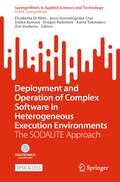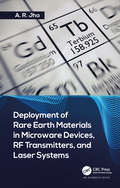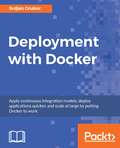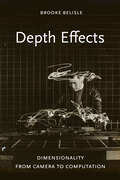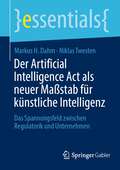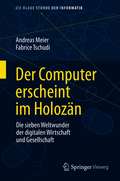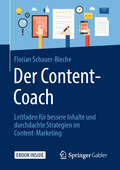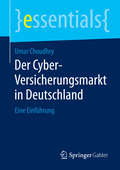- Table View
- List View
Deploying AI in the Enterprise: IT Approaches for Design, DevOps, Governance, Change Management, Blockchain, and Quantum Computing
by Eberhard Hechler Martin Oberhofer Thomas SchaeckYour company has committed to AI. Congratulations, now what? This practical book offers a holistic plan for implementing AI from the perspective of IT and IT operations in the enterprise. You will learn about AI’s capabilities, potential, limitations, and challenges. This book teaches you about the role of AI in the context of well-established areas, such as design thinking and DevOps, governance and change management, blockchain, and quantum computing, and discusses the convergence of AI in these key areas of the enterprise.Deploying AI in the Enterprise provides guidance and methods to effectively deploy and operationalize sustainable AI solutions. You will learn about deployment challenges, such as AI operationalization issues and roadblocks when it comes to turning insight into actionable predictions. You also will learn how to recognize the key components of AI information architecture, and its role in enabling successful and sustainable AI deployments. And you will come away with an understanding of how to effectively leverage AI to augment usage of core information in Master Data Management (MDM) solutions.What You Will LearnUnderstand the most important AI concepts, including machine learning and deep learningFollow best practices and methods to successfully deploy and operationalize AI solutionsIdentify critical components of AI information architecture and the importance of having a planIntegrate AI into existing initiatives within an organizationRecognize current limitations of AI, and how this could impact your businessBuild awareness about important and timely AI researchAdjust your mindset to consider AI from a holistic standpointGet acquainted with AI opportunities that exist in various industriesWho This Book Is ForIT pros, data scientists, and architects who need to address deployment and operational challenges related to AI and need a comprehensive overview on how AI impacts other business critical areas. It is not an introduction, but is for the reader who is looking for examples on how to leverage data to derive actionable insight and predictions, and needs to understand and factor in the current risks and limitations of AI and what it means in an industry-relevant context.
Deploying Enterprise Systems: How to Select, Configure, Build, Deploy, and Maintain a Successful ES in Your Organization
by David MattsonThis book focuses on topics that business managers and project teams in global enterprises need to understand and follow to successfully deploy an Enterprise System (ES) for their organization. It explains: Why this type of software product will appeal to global organizations with the promise to replace their older individual systems with a single integrated ES and how an ES allows companies to integrate their unique operations with a single system of many integrated modules that are designed to provide prebuilt and tested applications; New concepts, steps, risks, and methods that an organization should follow to successfully create and deploy an ES; and the top 10 reasons that ES projects fail and the practices to manage these risks. In addition, the book describes a new Implementation Model and methods to ensure success in deploying an ES across a firm with several divisions, international operations, product lines, and infrastructure. Essentially, this book: Describes, in non-technical terms, what business functions this new software product will improve Shows how an enterprise should use this software product to accomplish their goals to install and use this new technology to upgrade their older systems Explains what an organization’s management and project teams should avoid during selecting, planning, and implementing their ES to avoid common mistakes Describes the skills and experience (including IT and general management) the Project Manager must have to lead the project team(s) to implement this advanced system.
Deploying Microsoft 365 Teamwork: Expert tips, techniques, and practices to pass the MS-300 exam on the first attempt
by Aaron GuilmettePrepare to achieve Microsoft 365 Certified Teamwork Administrator Associate certification by learning essential SharePoint Online concepts, and answering self-assessment questions to test your knowledge Key Features Cover essential topics based on the MS-300 exam, and learn with the help of detailed explanations Understand the collaborative features of SharePoint, both on-premises and as part of the Office 365 service Work through practice questions relating to business use cases for SharePoint Server and Online Book Description The Microsoft MS-300 exam is designed to test the knowledge and skills of administrators in deploying, configuring, and managing SharePoint Online, SharePoint Server, SharePoint Hybrid, OneDrive for Business, and Teams. This book offers up-to-date coverage of the important topics based on the MS-300 exam and features question answers and insider tips to help you prepare for certification. Written in a clear, succinct way, the book starts by helping you configure and manage SharePoint Online. You'll then delve into OneDrive for Business, right from managing users and groups, through to monitoring sharing and security. Further chapters will guide you through working with Teams, with an emphasis on managing identity authentication, resolving issues with the service, and even observing usage patterns. Later, you'll get up to speed with workload integrations, covering the Yammer business communications platform, before moving on to understand how to integrate Microsoft Stream with SharePoint, Teams, and Yammer. Finally, you'll learn to develop data governance and user adoption strategies. By the end of this book, you'll be well-versed with SharePoint Online and have learned the essential techniques and concepts you need to know in order to pass the MS-300 certification exam. What you will learn Discover the different Microsoft services and features that make up Office 365 Configure cloud services for your environment and extend your infrastructure's capabilities Understand site architecture, site settings, and hub settings in SharePoint Online Explore business connectivity services for view and access options in SharePoint Online Configure Yammer to integrate with Office 365 groups, SharePoint, and Teams Deploy SharePoint Online, OneDrive for Business, and Microsoft Teams successfully, including bots and connectors Who this book is for This book is for SharePoint developers, administrators, or those who want to explore Microsoft's teamwork solution platforms and pass the certification exam to boost their career as Microsoft Teamwork Administrator Associates. Anyone who has achieved Microsoft's entry-level admin certification and wants to progress to intermediate certification will also find this book useful.
Deploying Microsoft® Forefront® Protection 2010 for Exchange Server
by Yuri Diogenes Thomas W. ShinderGet focused, real-world guidance for planning and implementing Forefront Protection for Exchange Server--and help protect enterprise e-mail from viruses, spam, phishing, and policy violations. Guided by key members of the Microsoft Forefront team, you'll delve into system components, features, and capabilities, and step through essential planning and design considerations. Deployment scenarios for Forefront Protection for Exchange include the Edge server, to inspect e-mail moving into and out of the corporate network; Exchange Hub Transport Server, to inspect e-mail moving within the organization; and mailbox servers, to inspect the contents of the user e-mail boxes and provide real-time protection against malicious attachments.
Deploying Microsoft® Forefront® Threat Management Gateway 2010
by Yuri Diogenes Thomas W. ShinderGet the focused, scenario-based guidance you need to plan and deploy Forefront Threat Management Gateway (TMG) as your network perimeter firewall. The evolution of Microsoft ISA Server, Forefront TMG provides multiple layers of continuously updated protections against the latest Web-based threats, including URL filtering, antimalware inspection, and intrusion prevention. Led by two members of the Microsoft Forefront team, you'll get pragmatic, inside insights into system components and capabilities; identify software, hardware, and business requirements; and step through essential planning and design considerations, including network topology, remote access, publishing rules, performance, administration, and more.
Deploying Microsoft® Forefront® Unified Access Gateway 2010
by Yuri Diogenes Thomas W. ShinderPlan, design, and deploy Forefront United Access (UAG) with insights straight from the Forefront team at Microsoft. Forefront Unified Access Gateway (UAG)--the evolution of the Microsoft Intelligent Application Gateway (IAG)--delivers a more robust and transparent solution for inbound access from anywhere. This pragmatic guide drills into system components and capabilities, identifies software and hardware requirements, and provides scenario-based advice for planning and design, including policy control and availability and scalability considerations. You'll learn how to plan and deploy an SSL VPN solution for your environment, and how to publish applications through Forefront UAG, including Microsoft Exchange Server, SharePoint® 2010, and Windows Server® 2008 Remote Desktop Services.
Deploying Node.js
by Sandro PasqualiIf you are an intermediate or advanced developer deploying your Node.js applications, then this book is for you. If you have already built a Node application or module and want to take your knowledge to the next level, this book will help you find your way.
Deploying OpenStack: Creating Open Source Clouds
by Ken PeppleOpenStack was created with the audacious goal of being the ubiquitous software choice for building public and private cloud infrastructures. In just over a year, it's become the most talked-about project in open source. This concise book introduces OpenStack's general design and primary software components in detail, and shows you how to start using it to build cloud infrastructures.If you're a developer, technologist, or system administrator familiar with cloud offerings such as Rackspace Cloud or Amazon Web Services, Deploying OpenStack shows you how to obtain and deploy OpenStack software in a few controlled scenarios.Learn about OpenStack Compute (known as “Nova”), OpenStack Object Store ("Swift"), and OpenStack Image Service ("Glance")Understand common pitfalls in architecting, deploying, and implementing your cloud infrastructure with OpenStackDetermine which version of the OpenStack code base best suits your deployment needsDefine your deployment scenario and finalize key design choicesInstall Nova on a single node with either the StackOps distro or an Ubuntu packageBe familiar with important configuration options and important administrative commands
Deploying Rails with Docker, Kubernetes and ECS
by Pablo AcuñaLearn how to use the power of Docker and Kubernetes to deploy your Rails applications easily and efficiently. Deploying Rails with Docker, Kubernetes and ECS shows you how to set up the project, push it to DockerHub, manage services and set up an efficient continuous integration environment. Every concept is clearly explained alongside a full Ruby on Rails application deployment. You’ll also learn how to deploy via Docker using Amazon EC2 Container Service.Docker and Kubernetes are increasing in popularity every day, but what if you want to leverage their benefits for your Rails application? This is the quick guide you need.What You Will LearnCreate a Rails API application using Rails 5 and PostgreSQL, and Dockerize itWrite and test templates to run the application with KubernetesCreate a Kubernetes cluster in Amazon Web Services and run yourInspect and troubleshoot problems in the clusterAutomatize the the whole deployment process with JenkinsWho This Book Is ForThis book is for anyone who wants to understand how to effectively deploy a Rails application using Docker and Kubernetes. You will need to understand Rails and have basic knowledge of what Docker and Kubernetes are used for.
Deploying Raspberry Pi in the Classroom
by Guy Hart-DavisLearn how to deploy Raspberry Pi computers in a classroom or lab situation and how to navigate the hardware and software choices you face. Deploying Raspberry Pi in the Classroom equips you with the skills and knowledge to plan and execute a deployment of Raspberry Pi computers in the classroom. Teachers and IT administrators at schools will see how to set up the hardware and software swiftly on your own or with the help of your students. Step-by-step instructions and practical examples walk you through building your Raspberry Pi workstations and your network, managing the computers and the network, and troubleshooting any problems that arise. This book offers several points to involve your students through hands-on activities. These activities are designed to benefit your beginner and older or more able students alike. Make Deploying Raspberry Pi in the Classroom a part of you instructional library today. What you will learn Put an easily-manageable computer on each desk for students to learn Internet use and essential office software skills Image, configure, and plan a classroom deployment of Raspberry Pi computers Manage your classroom Raspberry Pi computers and keeping them up and running smoothly and efficiently Who this book is for Primary audience would be teachers and IT administrators at schools or colleges. It will also appeal to administrators at social clubs or organizations that provide less formal tuition or simply provide Internet access.
Deploying SharePoint 2016
by Vlad Catrinescu Trevor SewardSee how to install, configure, and maintain the latest release of Microsoft's popular SharePoint Server, SharePoint 2016. This latest version brings with it many changes for IT professionals. Read Deploying SharePoint 2016 to find out how to create a performant and stable SharePoint environment for your company. What You'll Learn: Install SharePoint Server 2016, both using the user interface provided by Microsoft, and by using PowerShell. Understand your authentication options and associated security considerations. Deploy add-ins, either from the store, or from your own custom app catalog. Configure Search Service Application using either the provided UI or PowerShell. Configure business intelligence components such as Excel Services, SQL Server Reporting Services, and PowerPivot. Migrate to SharePoint Server 2016 from either SharePoint Server 2010 or 2013. Understand approaches to high availability, disaster recovery, patching, and ways to monitor and maintain your SharePoint 2016 deployment once it's up and running. Who This Book Is For: Anyone tasked with installing, configuring, and maintaining SharePoint Server 2016 in their organization. This book assumes some working knowledge of a previous release of SharePoint Server, such as SharePoint 2010 or SharePoint 2013.
Deploying SharePoint 2019: Installing, Configuring, and Optimizing for On-Premises and Hybrid Scenarios
by Vlad Catrinescu Trevor SewardUpdate to a version of SharePoint that offers the best of both on-premise and the cloud using SharePoint 2019, the latest release of this cornerstone technology from Microsoft. Don your technical learning hat to get up close and confident on the new time-saving modern features of on-premise, and the many new security and hybrid settings.Deploying SharePoint 2019 begins with a general introduction to SharePoint 2019, covering new features and expanding your knowledge and capability with the technology systematically. You will learn about the new world of SharePoint, and how it was “cloud-born” from Office 365. From there you will dive into learning how to design a physical architecture for SharePoint Server 2019 and get familiar with the key concepts of high availability (HA) and disaster recovery (DR) solutions. What You'll Learn Install, configure, and optimize SharePoint 2019Understand SharePoint 2019 as a hybrid frameworkGet comfortable with new tools, such as Flow, PowerApps, and Power BIConfigure systems connected to SharePoint, such as Office Online Server and Workflow ManagerMigrate content and service databases from previous versions of SharePoint to SharePoint 2019Implement HA and DR topologies with SharePoint 2019 to satisfy business continuity requirements Who This Book Is For Those tasked with installing, configuring, and maintaining SharePoint Server 2019 for their organization. This book assumes some working knowledge of a previous release of SharePoint Server, such as SharePoint 2013 or SharePoint 2016.
Deploying SharePoint Server Hybrid: Expert tips, techniques, and best practices to pass the MS-301 exam on the first attempt
by Aaron GuilmetteDiscover expert guidance to achieve the Microsoft 365 Certified Teamwork Administrator Associate certification and become proficient in working with SharePoint Server hybrid configuration Key Features Discover how to deploy, configure, and administer the SharePoint ecosystem Learn how to map traditional Microsoft services to a cloud-services model Understand the security and governance requirements and configurations of your organization Book Description The Microsoft MS-301 exam validates the knowledge and skills you need for deploying, configuring, and managing SharePoint Server and SharePoint Hybrid, as well as migrating to SharePoint Online. This SharePoint book offers complete, up-to-date coverage of the MS-301 exam syllabus, helping you take the exam with confidence, fully equipped to pass the first time. With the help of clear and succinct explanations, self-assessment questions, tips, and mock exams with detailed answers, this book covers the configuration of SharePoint Server and SharePoint Hybrid and the process of migrating to SharePoint Online. This study guide is divided into three modules. The first two modules focus on strategies and techniques to configure and manage SharePoint on-premises and hybrid scenarios, where you'll get to grips with essential concepts relating to SharePoint deployments, such as authentication, Business Connectivity Services (BCS), and the data gateway. The third module will take you through migration methods and strategies. Each chapter includes practice questions to test your knowledge of the concepts covered. By the end of this book, you'll have learned everything you need to pass the MS-301 certification exam, and you'll be able to use this reference guide for your administration tasks. What you will learn Understand the collaborative features of SharePoint Server technologies Deploy and configure SharePoint Server 2019 Configure and manage site collections and hub site settings and security Use migration tools in SharePoint to manage data migration Explore BCS for working with external data sources Get to grips with different types of authentication available in SharePoint Online Who this book is for The book is for intermediate administrators who want to pass the MS-301 exam and achieve the Microsoft 365 Certified: Teamwork Administrator Associate certification. Anyone looking to learn about deploying, configuring, and administering SharePoint, OneDrive, and Teams will find this book useful. The book assumes a working knowledge of popular Microsoft services and a basic understanding of working with the SharePoint ecosystem.
Deploying and Managing a Cloud Infrastructure
by Salman Ul Haq Abdul Salam Zafar GilaniLearn in-demand cloud computing skills from industry expertsDeploying and Managing a Cloud Infrastructure is an excellent resource for IT professionals seeking to tap into the demand for cloud administrators. This book helps prepare candidates for the CompTIA Cloud+ Certification (CV0-001) cloud computing certification exam. Designed for IT professionals with 2-3 years of networking experience, this certification provides validation of your cloud infrastructure knowledge.With over 30 years of combined experience in cloud computing, the author team provides the latest expert perspectives on enterprise-level mobile computing, and covers the most essential topics for building and maintaining cloud-based systems, including:Understanding basic cloud-related computing concepts, terminology, and characteristicsIdentifying cloud delivery solutions and deploying new infrastructureManaging cloud technologies, services, and networksMonitoring hardware and software performanceFeaturing real-world examples and interactive exercises, Deploying and Managing Cloud Infrastructure delivers practical knowledge you can apply immediately. And, in addition, you also get access to a full set of electronic study tools including:Interactive Test EnvironmentElectronic FlashcardsGlossary of Key TermsNow is the time to learn the cloud computing skills you need to take that next step in your IT career.
Deploying the Zero Trust Framework in MSFT Azure (Cyber Shorts)
by Ravindra DasThe Cloud is fast becoming the de facto standard for businesses in Corporate America today, with Microsoft Azure being one of the most widely used systems. However, given its stature, it has also become a prime target for the cyberattacker. Thus, a Zero Trust Framework is strongly needed. Deploying the Zero Trust Framework in MSFT Azure takes a closer look at the Cloud, the Zero Trust Framework, and how to deploy from both the technical and psychological perspectives.
Deploying to OpenShift: A Guide for Busy Developers
by Graham DumpletonGet an in-depth tour of OpenShift, the container-based software deployment and management platform from Red Hat that provides a secure multi-tenant environment for the enterprise. This practical guide describes in detail how OpenShift, building on Kubernetes, enables you to automate the way you create, ship, and run applications in a containerized environment.Author Graham Dumpleton provides the knowledge you need to make the best use of the OpenShift container platform to deploy not only your cloud-native applications, but also more traditional stateful applications. Developers and administrators will learn how to run, access, and manage containers in OpenShift, including how to orchestrate them at scale.Build application container images from source and deploy themImplement and extend application image buildersUse incremental and chained builds to accelerate build timesAutomate builds by using a webhook to link OpenShift to a Git repositoryAdd configuration and secrets to the container as project resourcesMake an application visible outside the OpenShift clusterManage persistent storage inside an OpenShift containerMonitor application health and manage the application lifecycleThis book is a perfect follow-up to OpenShift for Developers: A Guide for Impatient Beginners (O’Reilly).
Deploying with JRuby 9k: Deliver Scalable Web Apps Using the JVM
by Joe KutnerDeploy using the JVM's high performance while building your apps in the language you love. This book introduces you to three JRuby deployment strategies that give you the performance and scalability you need, while you use a language designed for rapid development. Explore common deployment scenarios, including consolidating an MRI-based Ruby deployment onto a single JVM process and porting a Rails application to JRuby, getting it into production, and keeping it running. This new edition has new chapters on Puma, performance tuning, and Java integration, and is updated to the latest versions of JRuby 9k, Rails 4, and JDK 8.JRuby is a fast, scalable, and powerful JVM language with all the benefits of a traditional Ruby environment. JRuby deployments have fewer moving parts and consume less memory than traditional Ruby. With this book, you can now use JRuby in the real world to build high-performance, scalable applications.Deploying your apps on the JVM requires some new approaches. Start by creating a JRuby microservice that takes advantage of the JVM's native concurrency. Then use Docker to build a virtual production environment that's a stable, reproducible place to explore JRuby deployment. Next, port an existing Rails application to JRuby, preparing the app to take advantage of the JVM platform--all while keeping everything that's friendly and familiar to Ruby developers. Deploy the Rails app to Docker with a multi-threaded Puma server to Heroku or your own private cloud.Take advantage of powerful Java libraries. See how JRuby fits into the enterprise by switching your app to use TorqueBox, an all-in-one JRuby environment that includes built-in support for messaging, scheduling, and daemons--perfect for handling the big jobs. Finally, take a deep dive into JVM performance tuning and set up a continuous deployment environment with Travis CI.What You Need:To run the examples in this book, you'll need a computer that can run the Java Virtual Machine and a connection to the Internet.
Deployment and Operation of Complex Software in Heterogeneous Execution Environments: The SODALITE Approach (SpringerBriefs in Applied Sciences and Technology)
by Elisabetta Di Nitto Jesús Gorroñogoitia Cruz Indika Kumara Dragan Radolović Kamil Tokmakov Zoe VasileiouThis open access book provides an overview of the work developed within the SODALITE project, which aims at facilitating the deployment and operation of distributed software on top of heterogeneous infrastructures, including cloud, HPC and edge resources. The experts participating in the project describe how SODALITE works and how it can be exploited by end users. While multiple languages and tools are available in the literature to support DevOps teams in the automation of deployment and operation steps, still these activities require specific know-how and skills that cannot be found in average teams. The SODALITE framework tackles this problem by offering modelling and smart editing features to allow those we call Application Ops Experts to work without knowing low level details about the adopted, potentially heterogeneous, infrastructures. The framework offers also mechanisms to verify the quality of the defined models, generate the corresponding executable infrastructural code, automatically wrap application components within proper execution containers, orchestrate all activities concerned with deployment and operation of all system components, and support on-the-fly self-adaptation and refactoring.
Deployment of Rare Earth Materials in Microware Devices, RF Transmitters, and Laser Systems
by Ph. D. A. R. JhaDeployment of Rare Earth Materials in Microware Devices, RF Transmitters, and Laser Systems describes the deployment of rare earth materials that offer significant improvement in the RF performance, reliability, weight, and size of microwave devices, RF transmitters, and laser systems. RF components, microware transmitters, laser systems, and special timing devices are described, with an emphasis on improvement in the performance parameters.
Deployment with Docker
by Srdjan GruborA practical guide to rapidly and efficiently mastering Docker containers, along with tips and tricks learned in the field. About This Book • Use Docker containers, horizontal node scaling, modern orchestration tools (Docker Swarm, Kubernetes, and Mesos) and Continuous Integration/Continuous Delivery to manage your infrastructure. • Increase service density by turning often-idle machines into hosts for numerous Docker services. • Learn what it takes to build a true container infrastructure that is scalable, reliable, and resilient in the face of increased complexities from using container infrastructures. • Find out how to identify, debug, and mitigate most real-world, undocumented issues when deploying your own Docker infrastructure. • Learn tips and tricks of the trade from existing Docker infrastructures running in production environments. Who This Book Is For This book is aimed at system administrators, developers, DevOps engineers, and software engineers who want to get concrete, hands-on experience deploying multi-tier web applications and containerized microservices using Docker. This book is also for anyone who has worked on deploying services in some fashion and wants to take their small-scale setups to the next level (or simply to learn more about the process). What You Will Learn • Set up a working development environment and create a simple web service to demonstrate the basics • Learn how to make your service more usable by adding a database and an app server to process logic • Add resilience to your services by learning how to horizontally scale with a few containers on a single node • Master layering isolation and messaging to simplify and harden the connectivity between containers • Learn about numerous issues encountered at scale and their workarounds, from the kernel up to code versioning • Automate the most important parts of your infrastructure with continuous integration In Detail Deploying Docker into production is considered to be one of the major pain points in developing large-scale infrastructures, and the documentation available online leaves a lot to be desired. With this book, you will learn everything you wanted to know to effectively scale your deployments globally and build a resilient, scalable, and containerized cloud platform for your own use. The book starts by introducing you to the containerization ecosystem with some concrete and easy-to-digest examples; after that, you will delve into examples of launching multiple instances of the same container. From there, you will cover orchestration, multi-node setups, volumes, and almost every relevant component of this new approach to deploying services. Using intertwined approaches, the book will cover battle-tested tooling, or issues likely to be encountered in real-world scenarios, in detail. You will also learn about the other supporting components required for a true PaaS deployment and discover common options to tie the whole infrastructure together. At the end of the book, you learn to build a small, but functional, PaaS (to appreciate the power of the containerized service approach) and continue to explore real-world approaches to implementing even larger global-scale services. Style and approach This in-depth learning guide shows you how to deploy your applications in production using Docker (from the basic steps to advanced concepts) and how to overcome challenges in Docker-based infrastructures. The book also covers practical use-cases in real-world examples, and provides tips and tricks on the various topics.
Depth Effects: Dimensionality from Camera to Computation
by Brooke BelisleIn this bold rewriting of visual culture, Brooke Belisle uses dimensionality to rethink the history and theory of media aesthetics. With Depth Effects, she traces A.I.-enabled techniques of computational imaging back to spatial strategies of early photography, analyzing everyday smartphone apps by way of almost-forgotten media forms. Drawing on the work of Maurice Merleau-Ponty, Belisle explores depth both as a problem of visual representation (how can flat images depict a voluminous world?) and as a philosophical paradox (how do things cohere beyond the limits of our view?). She explains how today's depth effects continue colonialist ambitions toward totalizing ways of seeing. But she also shows how artists stage dimensionality to articulate what remains invisible and irreducible.
Der Artificial Intelligence Act als neuer Maßstab für künstliche Intelligenz: Das Spannungsfeld zwischen Regulatorik und Unternehmen (essentials)
by Markus H. Dahm Niklas TwestenDieses Buch betrachtet das Spannungsfeld zwischen regulatorischen Anforderungen des Artificial Intelligence Acts (AIA) der Europäischen Union auf das Ökosystem von Unternehmen. Insbesondere die Auswirkungen auf Prozesse, Governance-Strukturen und Systeme in einem Unternehmen werden beleuchtet. Hierzu werden Grundlagen der künstlichen Intelligenz und Anforderungen aus dem Verordnungsentwurf erläutert. Außerdem werden die Dimensionen Prozesse, Governance-Strukturen und Systeme eines Unternehmens beschrieben. Abschließend werden Handlungsfelder und Handlungsempfehlungen aufgezeigt, die sich für Unternehmen aus der Einführung des AIA ergeben.Der InhaltGrundlagen der künstlichen Intelligenz Grundlagen zum KI-Act der europäischen Union Chancen und Risiken für Unternehmen durch den KI-ActHandlungsempfehlungen für Unternehmen im Kontext des KI-Acts
Der Computer erscheint im Holozän: Die sieben Weltwunder der digitalen Wirtschaft und Gesellschaft (Die blaue Stunde der Informatik)
by Andreas Meier Fabrice TschudiDie sieben Weltwunder wurden bereits in der Antike beschrieben, etwa zur selben Zeit wie die mechanische Rechenhilfe Abacus, ein Zählrahmen mit Holz- oder Glasperlen. Dieses Buch beschreibt und diskutiert die sieben Weltwunder der IT, ohne die unsere digitale Wirtschaft und Gesellschaft kaum überlebensfähig scheint: Computermaus, Datenbanken, Kryptografie, Graphgrammatiken, Internet, Blockchain und Soft Computing. Jedes Weltwunder der IT wird kurz charakterisiert, bevor Anwendungsoptionen für Wirtschaft und Gesellschaft exemplarisch aufgezeigt und gewürdigt werden. Das Werk richtet sich an alle, die sich mit der digitalen Transformation auseinandersetzen. Es soll helfen, digitale Entwicklungen im eigenen Unternehmen, in der Verwaltung oder im öffentlichen wie im privaten Leben zu positionieren und zu reflektieren.
Der Content-Coach: Leitfaden für bessere Inhalte und durchdachte Strategien im Content-Marketing
by Florian Schauer-BiecheVorsicht: dieses Buch ist nichts für Theoretiker. Dieses Buch ist für Macher und Umsetzer. Sind Sie zufrieden mit Ihrer Kommunikation? Ist Ihr Content gut genug, um die Konkurrenz abzuhängen? Wenn nicht, springen Sie gleich zu Seite 1. Sie halten hier Ihren persönlichen Content-Coach in den Händen. Egal ob Sie Unternehmer, Manager oder einfach ein an Content interessierter Mensch sind: Dieses Buch ist für alle, die nicht länger „irgendwas mit Content“ machen wollen, sondern künftig von sich behaupten möchten: Ich weiß wie es geht! Lernen Sie die Grundlagen der menschlichen Kommunikation und Storytelling. Holen Sie sich Anleitungen aus der Praxis. Die Tipps dieses Buches kommen aus dem echten Leben. Es sind Antworten auf Fragen und Aufgaben von Kunden und Seminarteilnehmern. Die Lösungen, die Sie hier erhalten, haben den Reality-Check bestanden. Der Content-Coach begleitet Sie bei der Ideenfindung und der Konzept- und Strategieentwicklung, der Contenterstellung, der Prozessentwicklung und beim Training Ihrer Mitarbeiter. Aus dem InhaltIst Ihre Herangehensweise bei der Erstellung von Inhalten richtig?Wie erzählt man Geschichten? Wie wird eine Idee zur Story?Welches Basiswissen braucht ein Content-Creator?Wie erstellt man gute Inhalte und was macht gute Inhalte aus? Wie wertet man die Content-Arbeit innerhalb von Unternehmen auf?Wie vermarktet und verbreitet man Inhalte?Wie sieht der Content der Zukunft aus und sind Sie dafür gerüstet? Der AutorFlorian Schauer-Bieche ist Content-Coach, Design-Thinker und Kommunikationsberater. Er berät internationale Unternehmen und hält Vorträge und Seminare. Der „gelernte“ Journalist ist umtriebiger Unternehmer und Gründer der Initiative „BreakTheRules.Today“ und hat skill.casa ins Leben gerufen, die erste Content-Agentur für Sprachassistenten in Österreich.
Der Cyber-Versicherungsmarkt in Deutschland: Eine Einführung (essentials)
by Umar ChoudhryDiese Dokumentation schlägt eine Schneise durch das Dickicht des Versicherungsmarktes der Cyber-Policen. Versicherungen gegen Cyberkriminalität werden zunehmend wichtiger: Angriffe auf die Informationstechnik von Unternehmen können Schäden in Millionenhöhe hinterlassen, beispielsweise wenn sensible Datensätze gestohlen oder Seiten von Online-Shops lahmgelegt werden. Inzwischen bietet die deutsche Versicherungswirtschaft mit speziellen ,,Cyber-Policen" Schutz gegen eine Vielzahl von IT-Risiken. Doch wie schlagkräftig ist ein solcher Schutz? Welche Versicherer bieten spezielle Cyber-Policen an? Welche Gefahren können versichert werden? Welche Rolle spielt der Versicherungsvertrieb und worauf sollten Vermittler und Makler achten? Das sind nur einige der Fragen, denen Umar Choudhry nachgeht.
